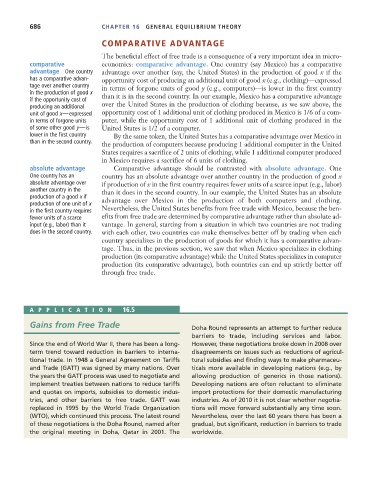Page 712 - Microeconomics, Fourth Edition
P. 712
c16GeneralEquilibriumTheory.qxd 8/16/10 9:14 PM Page 686
686 CHAPTER 16 GENERAL EQUILIBRIUM THEORY
COMPARATIVE ADVANTAGE
The beneficial effect of free trade is a consequence of a very important idea in micro-
comparative economics: comparative advantage. One country (say Mexico) has a comparative
advantage One country advantage over another (say, the United States) in the production of good x if the
has a comparative advan- opportunity cost of producing an additional unit of good x (e.g., clothing)—expressed
tage over another country in terms of forgone units of good y (e.g., computers)—is lower in the first country
in the production of good x than it is in the second country. In our example, Mexico has a comparative advantage
if the opportunity cost of
producing an additional over the United States in the production of clothing because, as we saw above, the
unit of good x—expressed opportunity cost of 1 additional unit of clothing produced in Mexico is 1/6 of a com-
in terms of forgone units puter, while the opportunity cost of 1 additional unit of clothing produced in the
of some other good y—is United States is 1/2 of a computer.
lower in the first country By the same token, the United States has a comparative advantage over Mexico in
than in the second country. the production of computers because producing 1 additional computer in the United
States requires a sacrifice of 2 units of clothing, while 1 additional computer produced
in Mexico requires a sacrifice of 6 units of clothing.
absolute advantage Comparative advantage should be contrasted with absolute advantage. One
One country has an country has an absolute advantage over another country in the production of good x
absolute advantage over if production of x in the first country requires fewer units of a scarce input (e.g., labor)
another country in the than it does in the second country. In our example, the United States has an absolute
production of a good x if advantage over Mexico in the production of both computers and clothing.
production of one unit of x
in the first country requires Nevertheless, the United States benefits from free trade with Mexico, because the ben-
fewer units of a scarce efits from free trade are determined by comparative advantage rather than absolute ad-
input (e.g., labor) than it vantage. In general, starting from a situation in which two countries are not trading
does in the second country. with each other, two countries can make themselves better off by trading when each
country specializes in the production of goods for which it has a comparative advan-
tage. Thus, in the previous section, we saw that when Mexico specializes in clothing
production (its comparative advantage) while the United States specializes in computer
production (its comparative advantage), both countries can end up strictly better off
through free trade.
APPLICA TION 16.5
Gains from Free Trade Doha Round represents an attempt to further reduce
barriers to trade, including services and labor.
Since the end of World War II, there has been a long- However, these negotiations broke down in 2008 over
term trend toward reduction in barriers to interna- disagreements on issues such as reductions of agricul-
tional trade. In 1948 a General Agreement on Tariffs tural subsidies and finding ways to make pharmaceu-
and Trade (GATT) was signed by many nations. Over ticals more available in developing nations (e.g., by
the years the GATT process was used to negotiate and allowing production of generics in those nations).
implement treaties between nations to reduce tariffs Developing nations are often reluctant to eliminate
and quotas on imports, subsidies to domestic indus- import protections for their domestic manufacturing
tries, and other barriers to free trade. GATT was industries. As of 2010 it is not clear whether negotia-
replaced in 1995 by the World Trade Organization tions will move forward substantially any time soon.
(WTO), which continued this process. The latest round Nevertheless, over the last 60 years there has been a
of these negotiations is the Doha Round, named after gradual, but significant, reduction in barriers to trade
the original meeting in Doha, Qatar in 2001. The worldwide.

